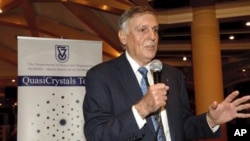An Israeli scientist whose research was initially met with skepticism and mockery has won the 2011 Nobel Prize for Chemistry. Daniel Shechtman’s discovery of "quasicrystals" nearly 30 years ago fundamentally changed the way scientists think about solid matter.
Daniel Shechtman, of the Technion - Israel Institute of Technology in Haifa, won the $1.4 million Nobel prize for his discovery that, contrary to conventional theories, atoms in a crystal could be packed into an asymmetrical, non-repeating pattern.
Royal Swedish Academy of Sciences member Lars Thelander said Wednesday the 70 year-old Israeli scientist’s work revolutionized our understanding of solid matter.
“His discovery of quasicrystals revealed a new principle for [the] packing of atoms and molecules in solid material," said Thelander. "This led to a paradigm shift within chemistry. It also stimulated two intense studies of the properties caused by the very special atomic packing.”
Until Shechtman’s research, scientists believed that crystals formed in regular and repeating patterns and lined up in predictable ways. In 1982, while working at a U.S. government laboratory, Shechtman found crystals with 10 points arranged in pentagonal symmetry, a phenomenon that appeared to violate the laws of nature. The discovery was so groundbreaking that many of his colleagues did not believe Shechtman, and he was eventually asked to leave his research group.
It wasn’t until 1987 that scientists in France and Japan succeeded in growing crystals large enough for x-rays to verify the Israeli scientist’s research.
The discovery shows that atoms can align in various ways that influence a material’s physical properties.
Speaking in Haifa after the Nobel prize announcement, Daniel Shechtman said he stands on the shoulders of others who helped lay the groundwork for his research.
"Yes, I have discovered it, but the science wouldn't be here, and wouldn't be as prosperous and complicated and intricate as it is, if not for the work of thousands of scientists around the world, and many of them [are] excellent, excellent scientists, who dedicated years for this," said Shechtman. "And so I feel proud for all this community. I feel great for them, and for me, yes."
A Swedish company has found quasicrystals in the strongest kinds of steel, which is used in razor blades and some surgical needles. The Academy said scientists were also experimenting with using quasicrystals in products as diverse as cookware and diesel engines.
Astrid Graslund is a professor of biophysics at Stockholm University and the Secretary of the Nobel Committee. She told Reuters that Shechtman’s Nobel Prize has less to do with the practical applications of quasicrystals and more with the discovery itself:
"Well, up to now you can say that wherever you need material which is very hard and non-reactive you could make this mixture with this," said Graslund. "Maybe you don't make a big car out of it but you could use it in different applications where you need special properties of the material. However, the most important thing is not the practical application, at least not yet. It's the concept."
Earlier this week, the Nobel prizes in medicine and physics were handed out. Thursday, the Nobel Prize for literature will be awarded. The Nobel Peace Prize will be announced Friday. A special Nobel Prize for economics will be awarded October 10.
The Nobel prizes were created by the 19th-century Swedish inventor, scientist, entrepreneur and peace activist, Alfred Nobel, who was also the inventor of dynamite. The first Nobel prizes were awarded in 1901.
Israeli Scientist Honored for Discovery of Unorthodox Crystals
- By David Byrd









